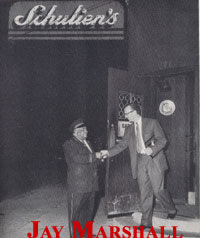Free Tricks & Articles
Clock Speller
Background:
The classic clock trick has been in print over and over again. John Bannon had what I felt was a very good climax for such an effect. John’s mathematical method for doing the effect was very interesting, but started with an elaborate stack. Using John’s idea, I have applied it to the standard clock effect and have eliminated the stack, but still get the great climax.
Effect
A spectator thinks of an hour of the day and takes that many cards from the top of the deck and hides them. A clock is made dealing cards around in a circle. The Magician turns around while the spectator looks at the card that is at the same position as his chosen hour. The clock is then taken apart and shuffled. The cards are now placed on the deck. The spectator is then asked to name his card and take the deck and spell the name of the card. So if the selection was the Seven of Diamonds, he takes one card for each letter and on the “S” turns over the card and it is indeed the selected card. The magician says that it is remarkable what happens at different times of the day. He asks what time the spectator thought of and then tells him to look at the bottom card of the deck that is the same numerical value as as the hour selected.
Technique & Patter:
-
Mark the back of any card that spells with twelve letters; for example the Jack of Hearts. I mark it by scratching small portions on the blue or red in all four corners on the back of a Bicycle card. The mark should be visible to you, but not to anyone looking at the back of the card. Place the marked card on the bottom of the deck.
-
Take the top twelve cards off the deck and have the spectator shuffle them. Demonstrate the shuffle by overhand shuffling the deck in your hands, shuffling the bottom card to the top of the deck. Explain that you want the spectator to think of an hour of the day and to take that many cards from his packet and place them in his pocket and place the balance of the cards back on the deck. Turn around so that you don’t see his selected number.
-
Pick up the deck and give it your best false shuffle or false cut. Deal the clock face as follows. Deal the top card of the deck face down at 12 o’clock, then deal the next card counter clockwise dealing 11, then 10, etc. I make sure that I turn the cards at 9,6 and 3 a little differently so that it is easy to understand where the hours are on the clock face. As you deal, watch where the marked card falls and remember the hour. You will be holding the deck after you dealt the clock. Once again turn around telling the spectator to look at the card that is at his hour on the clock. When you turn your back so that you do not see his selected hour, look through the deck and cut a card that is the same numerical value of the hour to the bottom of the deck. After the selection has been made, tell the spectator to destroy the clock by shuffling the cards.
-
Take back the shuffled clock packet and fan them so that the spectator can see that all the faces of the cards are different and that you can only see the backs. As you are showing the cards to the spectator, spot where the marked card is and hold a secret break under the card to the left of the marked card as you square the packet. Cut at the break to secretly deliver the selected card to second from the bottom of the packet. After the cut, you can flash the bottom card, everything will look random. Double undercut the bottom card of the deck to the top of the deck. Hand the deck to the spectator. Ask the spectator to name his card. Explain that he should spell the name of his card one card for each letter including “of” and ending on the “S.” Spell with him so there is no mistake. Have him turn over the card that he stopped on to show that it is indeed his selection. Deliver the line that strange things happen during certain times of the day, ask what hour he selected. Tell him to look at the bottom card on the face of the packet that he dealt off. He will be surprised that not only could he spell to his card, but also the hour mysteriously appeared on the bottom of the packet for a surprising climax.
-
I think that John’s spelling idea is a novel climax for the clock effect. Showing that you know the hour ties the clock effect together. Randy Wakeman suggested that the hour card should be on the bottom of the deck so that the magician can complete the effect without handling the cards. Simon Aronson suggested that the card should be the bottom of the packet and helped work out the handling. I think that Simon’s touch really makes the climax much less pat and much more surprising.
Leader’s Poker
Here is a variation of Tom Frame’s “Leadership Potential” [Linking Ring, pg. 88, April, 2001]. The difference in my variation and the way Tom submits effects is that I offer a new method and a new improved presentation. I feel that this is the kind of variation which makes sense to publish, but you be the judge!
Effect
Four Aces, four Kings, four Queens and four Jacks are placed in four packets, each containing only four cards on the table. The spectator is invited to switch the face up leader cards on adjacent packets and told that if he were playing Poker the higher value would always win therefore, the higher value leader causes the cards in it’s packet to follow the leader. The spectator is then invited to make another switch of two adjacent leaders and once again the higher value causes the cards to follow the leader. This leaves two packets and to complete the effect these two leaders are exchanged and again the higher leader cards follow the leader leaving the lowly Jack packet. This packet is shown to contain five cards, “A real poker hand,” and when it is shown it is a Straight Flush in Diamonds. The patter line is, “If you know the rules of Hoyle, a Straight Flush beats all other Fours of a kind”! I think that this is not a bad patter story and makes sense that the higher value is the leader since you never show the other packet. Read on because the method is even better!
Set-up
Set up the packet secretly before performing the effect as follows: From the face of the packet face up Jack, J, J, JD; Queen,Q,Q,Q; King,K,K,K; Ace,A,A,A; 7D,8D,9D,10D. The balance of the deck is face down on the table.
-
Show the Fours of a Kind in the same way. Hold the packet face up in left hand dealing position. Fan over the four Jacks into the right hand without changing their order. The right hand coalesces the four Jacks and flips them over face down onto the top of the left hand’s packet, but before they fall flush the left thumb catches them and holds them away from the rest of the packet so that the right hand can grasp the four Jacks and place them face down on the face down deck.
-
The patter is “Four Jacks” – Do exactly the same procedure for the Queens and the Kings each time pattering, “Four Queens, and four Kings.” Each time drop each four of a kind on the face down packet.
-
Follow through exactly in the same rhythm with the four Aces except hold the last five cards as one. Flip this packet face down into the left hand and follow through as before taking the cards by the right hand grasping above by the ends and dropping them onto the deck saying, “Four Aces.”
-
Pick up the face down deck and hold it in dealing position. Thumb over the top four cards getting a left little finger break under the fourth card. Square the packet onto the deck. The right hand picks up all the cards above the break from above by the ends and uses this packet to flip over the top card of the deck, an Ace which the left thumb deal onto the top of the right hand’s packet. The right hand takes apparently the four Aces as a packet with the top Ace face up and places the packet on the table on the left (packet A) – (This packet actually contains face up A, FD 10, FD 9, FD 8, and FD 7).
-
The work is now done because the next three packets are handled in the exact same way but cleanly. Thumb over the next three cards into the right hand, square them as a packet, and use the packet to flip over the top King placing it onto the packet. Place this packet to the right of the Ace packet (packet B).
-
As you are doing this again patter,” Four Kings.” Do step 5 again saying, “Four Queens” (packet C). Do step 5 again saying, “Four Jacks” (packet D). This packet handling was worked out with John Bannon.
-
Explain the game, telling the spectator that he can switch any adjacent Leader cards. The effect will work regardless of which two leader cards are exchanged, as long as the packets are adjacent. Let’s say that the spectator exchanges the face up King (packet B) and the face up Queen (packet C). Say that in this Poker game the highest card always wins, therefore in this example the King wins therefore, the Kings will follow the leader. Turn over packet C with the face up King to show the four Kings.
-
Tell the spectator that the only two adjacent packets are now packet A and packet B so switch the leader Ace and the leader Queen. Again say the high card, the Ace wins so the Aces will follow the leader. Show the four Aces.
-
That leaves packets A and D. Switch the face up leaders, the Queen and Jack and once again the Queen wins. Turn over the Queens.
-
The effect looks complete; turn over the face up Jack saying, “The lowly Jack.” Pick up this packet, spreading it, saying, “Five cards, a real Poker hand.” Turn them over to show them saying, ”All Red, all Diamonds, a Flush, as a matter of fact A Straight Flush which by the rules of Hoyle is the winner.”
-
If you like prediction effects, you can make a prediction before the effect starts, which says, “On the last switch the Jack hand will be last and become a Straight Flush that Wins.”
-
The idea of giving a choice of switching the adjacent leader cards is Tom Frame’s clever idea.
Schulien's Closes
I was lecturing at Magic Inc. on Wednesday January 27, 1999 for the IBM Ring when Jay Marshall announced that this was Schulien’s restaurant last night to be open. After my lecture I went to my old haunt. It was a surreal experience. When I walked in, there was Bobby Schulien greeting everyone as normal, but it was anything but normal. After 86 years the Schulien name would be dark in Chicago.
Strangely enough, I never saw Mat Schulien perform. He died in 1967 at the age of 76, but have heard so many stories about him and of course I am very familiar with his book and effects. I spent many nights watching Ed Schulien and later Charlie perform. The closing has been sped up by the untimely death of Charlie and some family squabbles, which I won’t go into.
My time spent there was an ongoing magic experience. When I walked in and saw one of the waitresses who used to wait on Ed Marlo and me, my heart felt weak. As I walked further into the restaurant I saw my old friends Steve Draun and JB Brash sitting at a table. I joined the group and my imagination ran wild. I just started staring at the table in the back with the Tiffany Light over it right by the portrait of Schulien himself. Memories started to fill my mind. I sat at that table beginning in 1970 through 1981 twice a week for seven hours at a time. I would meet Marlo at 7:00 PM and we would sit and discuss magic while eating dinner. Eddie was a particularly slow eater and he almost always ordered the same thing so there was no need for the waitress to even take his order. When we arrived, a glass of Sherry or white wine would arrive at the table at the same time as a hot cup of coffee which slowly but surely got cold as we sat there.
I would always finish my meal way before Marlo. He would cut his steak with the accuracy of doing a Faro Shuffle. It really didn’t bother me because he was always talking magic–card tricks and would even demonstrate or pantomime things as he ate. The ritual ended with the second cup of coffee and the cigar being unwrapped and the wrapper tied into a bow around the label. This was his trademark. We stayed there until Schulien’s closed. Charlie or whoever was on that night would come to the table and say, “OK boys, time to go home.” That was really the first call because Eddie was always in the middle of something. Either he was teaching me an effect or doing a variation or we were thinking about the solution to some card trick. When he was interrupted, he didn’t even acknowledge what was said. He just went on with business as usual. I would start to get my things together. Ed would sit until the lights started to go on and off and then he wouldn’t move unless he was absolutely ready. He babbled, “I can’t leave on a miss,” or, “Where are my gloves,” or, “Has anyone seen my muffler,” or, “I want to go to the Men’s room before I drive home.” The Schuliens knew the routine and almost as though he were a little boy would cater to all of his needs so that they could lock the doors only to have the event repeated every time that the great man appeared with another visiting magi. My nights were Wednesdays and Fridays unless a visiting Fireman (a magician) would come in town and Eddie wanted me to meet him, sometimes to protect him so that he wouldn’t have to do tricks for the guy. It all depended who the person was. The young gunslingers, as Marlo called them were the hardest for him to handle. He watched them “do their dance” and many times I think that they intimidated him and he would get up and put on his gloves and just say,” Kid or kids (as the case may be) you are really good,” shake their hands, and leave unexpectedly. Some of the people without mentioning names were shocked by this type of treatment, as was I when I saw it for the first time. It didn’t always happen that way, but there were moments with some very famous guys, which were really embarrassing.
So here I was at Schuliens for the last time and as I was sitting there these thoughts started to run into my mind. I almost could smell the cigar smoke and I expected Marlo to appear out of the bathroom where he had gone to practice an effect before performing it for me. I stayed there and watched Jay Marshall give an interview and heard Steve Draun tell of the time that Marlo offered to teach the punch deal for $25 and point the table right behind us and say, “That’s where I learned it, it was the best $25 I ever spent.”
The ghost of Marlo did not appear and after one beer, it was about all I could take. I will never forget those evenings at Schulien’s, it is where I learned to think and become a magician. Boy, those were the days!
Finessed Gymnastic Aces
Dr. James Nuzzo
Paul LePaul thought that this revelation of Aces was "one of the most spectacular of all four Ace effects" and it was first explained in The Card Magic of Le Paul (1949, pp. 207-211), with 11 photographs by Jerry McDermott. I was surprised that this revelation was not performed more often. I initially attributed this to an assumption that not many cardmen in the 50's and 60's had mastered the requisite Faro Weave. In my experience—one shared by many others—is that getting only the Aces to flip out during the flipping action was problematic. Other cards often flipped out and getting each flip out to look neatly uniform was seldom achieved. Dr. Nuzzo, however, figured out how to overcome this difficulty.
Effect: The four Aces are inserted into different parts of the deck and then the performer divides the deck in half and interlaces the two sections together to form an elongated deck. Then, holding this elongated deck at one end, he causes the Aces to flip out of the deck and face up onto the table one at a time.
Method: Le Paul used his technically varied Multiple Shift to control the Aces to the top. Dr. Nuzzo uses Marlo Simple Shift. Use any Multiple Shift or control that you prefer. The following explanation deals with only the way to set up the deck and flip out the Aces.
Once the Aces are on top, you want to perform Marlo's Straddle Faro technique. First, square the sides and ends of the pack as evenly as possible with both hands. Then press on the sides of the deck to square these sides with your left thumb and second finger while the right thumb and second finger press on the ends of the pack to square them. Both forefingers are curled on top and bottom of deck, respectively.
Turn the pack on its side so that left side is now uppermost. Your right hand releases its grip while your left fingers assume the following positions. The tip of left forefinger is placed at the front end. The ball of your left thumb is slightly below the center of deck on left side. Your left second, third and fourth fingers are on right side of deck with the rightside of deck pressing against the first creases of left second and third fingers while the left fourth finger has its full tip pressing against the side. (Photo 1)
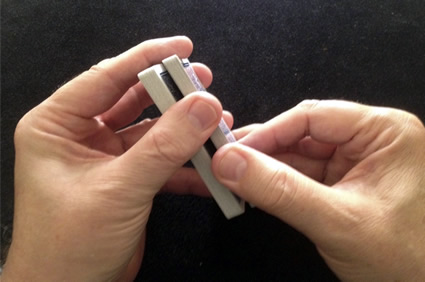
Your right hand comes over to undercut the larger section. Your left fourth finger moves out of the way so that the side of your right second finger comes in contact against left third finger. Your right forefinger is still curled on top. While the right second, third and fourth fingers press on the underside of the pack, your right thumb comes over close to the your left thumb and about ten cards above center, to break the pack at that point. (Photo 2)
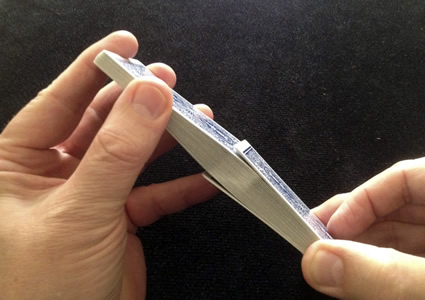
Having split the deck, take the lower, larger section away with your right hand and Straddle Faro it into the smaller portion that has the four Aces on top.
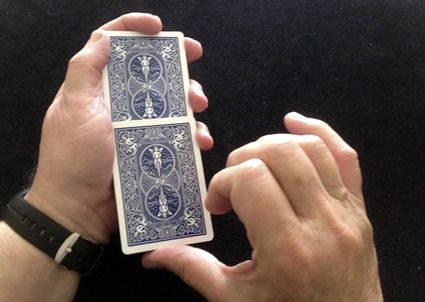
Once the portions are weaves together, steady and hold the elongated deck as shown in Photo 3 and use your right thumb to push its portion outward so that the outer white border is aligned with the lower rim of the "circle" showing the angel riding a bicycle. (This is exactly 1 5/8" from the outer end of each card.) (Photo 4)
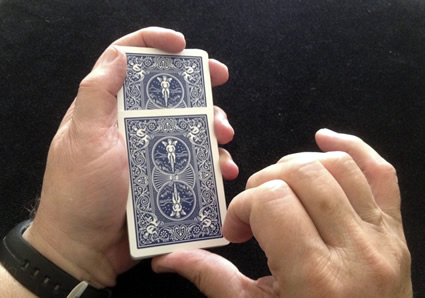
Next, using your left fingers, pat the outer end of the interlaced cards so that the cards are slightly beveled as shown in Photo 5.
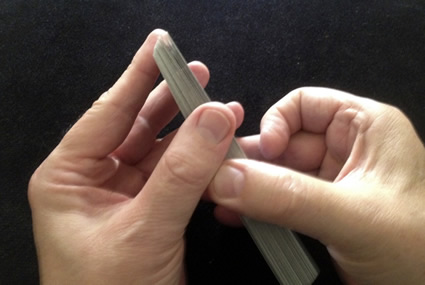
The next grip is important. Pinch the inner section tightly with your right hand with your thumb on top, your fingers underneath. The tip of your thumb should be midway at the precise place where the inner end of the outer section is wedged. (Photo 6)
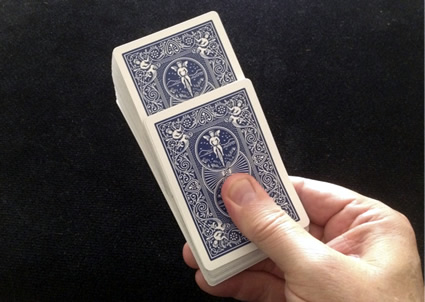
This will cause the outer end to flare. (Photo 7)
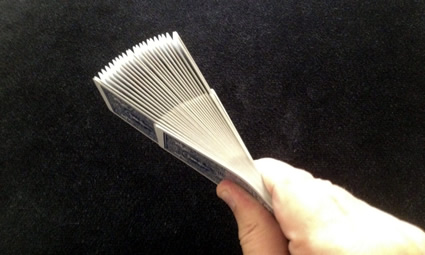
The next action is equally important. In the past, many performers tried to cause the Aces to flip out by making a sharp upward movement. This is wrong.
Instead, while holding the elongated deck with only your right hand, tilt it so that the outer end is up and the elongated deck is perpendicular to the table. (Photo 8)
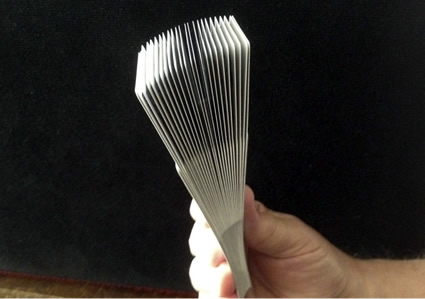
Then snap your wrist downward so that the elongated deck is
horizontal again. (Photo 9)
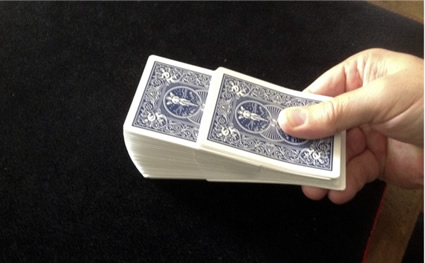
This loosens and releases the uppermost Ace or top card of the outermost section and causes it to spring up, out, and face up onto the table. (Photo 10)
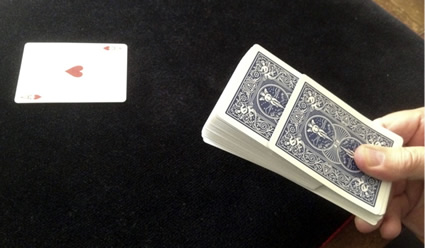
This requires a bit of practice to figure out how much of a "snapping action" must be exerted. In short, it requires (as they say) "a certain knack." However, you will see that each Ace will neatly flip out and no unwanted "strays" will join them. And, yes, spectators will assume that the Aces are flying out from within the section.
This dynamic disclosure has been part of Dr. Nuzzo's repertoire for over 40 years. Maybe now it will become part of yours?
August – 2012
Written by Jon Racherbaumer


